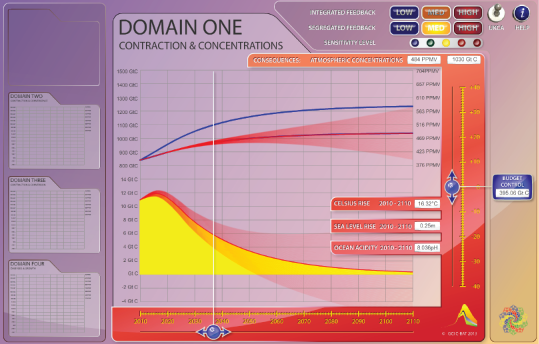
BACK TO CBAT Graphic User Interface [GUI]

BACK TO ALL INFO POINTS DOMAIN 1
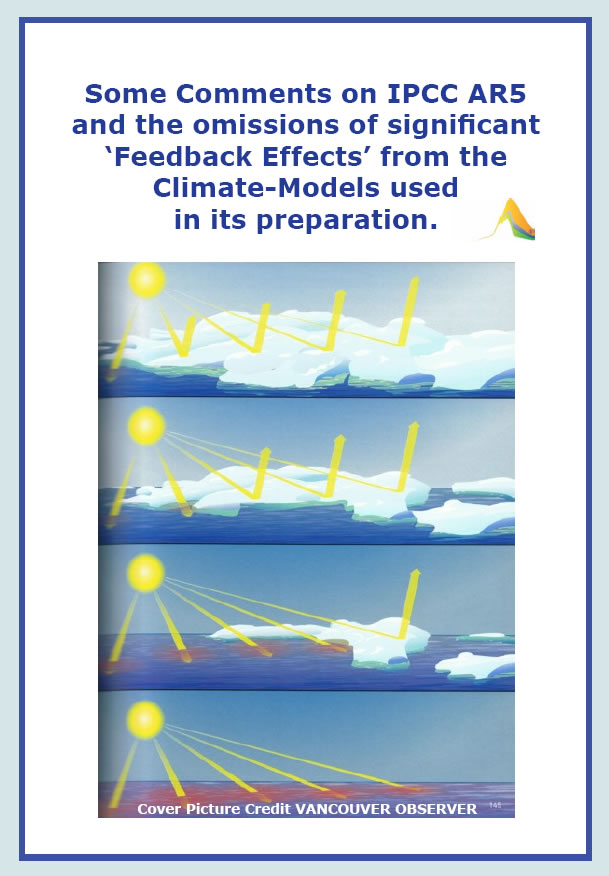
Comments relevant to IPCC AR5 & Feedback Omissions: -
- IPCC publishes ‘Under-stated’ 5th Assessment [AR5] September 2013.
- Summary of IPCC AR5 modelled climate projections
- Representative Concentration Pathways [RCPs] in AR5
- The UK House of Commons Environmental Audit Committee Enquiry
- An image of the UKMO’s ‘Carbon-Budget’ for the UK Climate Act [UKCA]
- Feedback Omissions; another form of Climate Denial?
- Summary of GCI Evidence to EAC the Enquiry
- The UKMO’s denial is now at the epicenter of the IPCC AR5
- GCI issued a press release about the UK ‘not safe’ UK Climate Act [UKCA]
- Source:Sink record; climate-policy-models & UNFCCC-compliance
- James Hansen ex-NASA tells EAC, UKCA “too weak.”
- Prof Peter Wadhams of Cambridge University on IPCC AR5 omissions
- Dr. T. Shindell of NASA ‘at present probability can’t be judged reliably.’
- Prof Peter Wadhams defends his analysis
- UNEP 2012 “Policy Implications of Warming Permafrost.” [Feedbacks]
- Nicholas Stern published slides at the IMF [05 2013] [Feedbacks]
- Various UKMO statements admitting omission of Feedbacks
- Carbon Budget Accounting Tool [CBAT] & Handling Omitted Feedbacks
- UKMO’s ‘Control Curves’ vs CBAT’s potential Loss of Control Curves
- CBAT Low Budget Domains 1 & 2 CBAT Medium [UKCA] “too weak.”
- Graphics [quoted] showing UKMO/RCP reconciliation exercise
- IPCC AR5 RCP 2.6 virtually is UKCA & “56% odds of exceeding 2° C.”
- FINAL DRAFT IPCC ARG WG1 TS on Climate Feedbacks [quoted]
- Some Responses to CBAT
1. IPCC publishes ‘Under-stated’ 5th Assessment [AR5] September 2013.
It is already clear IPCC AR5 under-represents the rate and the extent of the climate changes that are now increasingly likely to occur.
At the heart of this ‘conservatism’ is the omission of major feedback effects from the climate-models used to inform the AR5. In fact the entire suite of the climate-change projections in AR5 for the next 100 years come from models that omit significant ‘positive feedback’ effects from what are already starting to become potentially major sources of non-human carbon-emission releases.
Already people like Michael Mann a climate-scientist at Pennsylvania State University are commenting on this matter saying,
“The 2012 melt caused [climate] modellers to step back and say, ‘Maybe nature really is proceeding much faster than our models predicted'."
Quoted in the New York Times on August 19th he said: -
“IPCC has once again erred on the side of understating the degree of
likely changes,”
In a phrase, the key to understanding the true significance of these omitted feedback effects is that they make climate change self-propagating.
In other words they become completely beyond human control as they are not directly ‘human-budget-emissions’ which we can control, but ‘non-human-feedback-emissions’ which we cannot control and which will occur at an accelerating rate as the planet warms to and beyond ‘2 degrees up on the pre-industrial’ average in the decades ahead.
These omissions include increased atmospheric water vapour, increased CO2 and CH4 emissions from melting Permafrost in and around the Arctic, the loss of albedo [reflectivity] and the increase of negative-albedo as the ice melts.
The IPCC AR5 drafts do talk cautiously about these feedback effects and their potential consequences, which they confirm as serious and likely [see page 26]. Some conservatively predictive figures are cited in text. However, these are not coupled into the climate models used to generate the AR5 headline results in the Technical Summary and the Summary for Policy Makers.
In fact in the projected changes in radiative forcing, temperature and ocean pH [acidity] the effect of these feedback mechanisms are specifically omitted.
Consequently, the results from the so-called coupled carbon cycle modelling that is in the climate models used to generate these results in AR5 are inadequate and
unrealistic. They err on the side of significantly understating the rate and the
extent of the climate changes that are now increasingly likely to occur.
A summary of the emissions ‘control scenario’ [RCP 2.6] in the Technical
Summary and the Summary for Policy Makers in IPCC AR5 drafts follows.
2. Summary of IPCC AR5 modelled climate projections
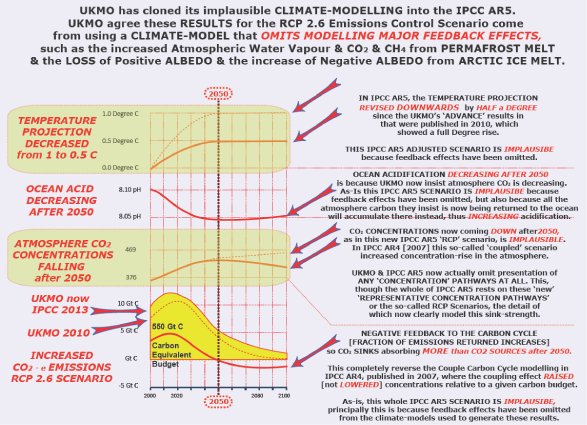
Over the Century ahead in this summary of IPCC AR5 we see that: -
- Temperature projections for this scenario have been halved from a one degree to only a half a degree rise
- Ocean acidification or pH drops by 0.05 to 2050 and then starts rising.
- In AR4 ‘coupled carbon-cycle modelling’ produced the opposite results as the fraction of ‘emissions-retained’ in the atmosphere increased.
- Atmospheric CO2 concentration starts falling after 2050 even though the 100 year emissions contraction-event is less than half way through.
- This means that CO2 sinks are stronger than sources by 2050 and so taking CO2 out of the atmosphere faster than we are adding it as the fraction of ‘emissions-returned from the atmosphere increased.
- Gigatonnage of the emission control budget [RCP 2.6] has actually been increased in weight since the 2010 projection by 10 -20%.
3. Representative Concentration Pathways [RCPs] in AR5
As the objective of the UNFCCC is achieving stable and safe concentration of GHG in the global atmosphere, atmospheric GHG concentrations have been modelled and shown for all emissions scenarios in all four previous IPCC Assessment Reports.
So it is quite remarkable that despite the new name - RCPs – and considering the objective of the UNFCCC, not one actual concentration pathway is shown anywhere in the IPCC AR5, neither in the Summary for Policy Makers nor in the Technical Summary. UKMO appear to have stopped showing them altogether.
These ‘Representative Concentration Pathways’ [RCPs] are available from Potsdam or IIASA [here]
The source-data is there for all to observe in this published material that is now the underpinning the entirety of AR5.
Getting the path trend for the fraction of emissions-returned increasing to more than 100% of emissions by 2050 is a simple extra calculation that can and actually needs to be performed. Once the calculation is done, the implausibility of emissions-contraction and concentrations relationship in AR5 becomes clear.
In a warming world, sink actions are most unlikely to accelerate the rate at which carbon is removed from the atmosphere, as the AR5 results show. The land-sinks cycle biological carbon – and not fossil carbon - and are already in retreat due to land-use changes.
The ocean sinks, where these returned biological carbon emissions would theoretically go, also accumulate, as the ‘biological pump’ cannot remove the extra carbon faster than has been the case to date. Moreover, the temperature and the acidification of the oceans are increasing as a generic result of continuing global warming. In yet another feedback loop, this too weakens, rather than strengthens, the sink activity.
An obvious contributory reason why these RCP-free results have the overly climate-conservative future they project, is that they result from climate-modelling that omits a range of significant positive feedback effects which will accelerate rather than slow the impending warming.
So it is irresponsible to makes these omissions and then suggest that things are not really so bad. Indeed, when these effects are admitted to the models, as many like Professor Peter Wadhams of Cambridge now robustly argue must be done, the IPCC AR5 results become under-estimates that are implausible and misleading about the increasing urgency of the situation we face with warming over the Century ahead [here]
The only way to have any chance of achieving UNFCCC-compliance and the climate-conservative future portrayed in AR5, is to stop digging fossil carbon out of the ground and burning it to emissions into the atmosphere. We need to leave it there and at least halve the size of the ‘emissions budget’ in the RCP 2.6 scenario, so human budget emissions are zero globally by 2050 at the latest. [See CBAT LOW BUDGET Page]
Many are now taking up this call for the correction of the climate models. In 2012, Kevin Schaefer of Boulder University Colorado USA wrote a UNEP Report, ‘Policy Implications of Warming Permafrost’. In this it was clearly stated: -
The effect of the permafrost carbon feedback on climate has not been included in the IPCC Assessment Reports. None of the climate projections in the IPCC Fourth Assessment Report include the permafrost carbon feedback (IPCC 2007). Participating modelling teams have completed their climate projections in support of the Fifth Assessment Report, but these projections do not include the permafrost carbon feedback. Consequently, the IPCC Fifth Assessment Report, due for release in stages between September 2013 and October 2014, will not include the potential effects of the permafrost carbon feedback on global climate.
Publishing from IMF in May this year [2013], even Sir Nicholas Stern observed: -
”The scientific models mostly leave out dangerous feedbacks/tipping points. At 6°, 5°, 4° C or below, the probability of passing some tipping points, such as melting of permafrost, may be high. If modellers cannot capture or model effects ‘sufficiently clearly’ they are omitted, but best guess surely not zero.”
There is no disagreement amongst modellers that the feedback factors, omitted due to issues of complexity and uncertainty, are in fact very difficult to model. Estimating release weights, dates and rates is difficult to due to lack of data gathering. It is also because these effects are beyond human control and they interact with each other, potentially accelerating the full-spectrum warming effect. Sir Nicholas Stern was correct to say that just leaving these effects out of the models is a mistake and is not a solution.
Since the publication of IPCC AR4, these RCP ‘scenarios’ have replaced the former SRES scenarios used since 2000 when they were first published. The UK Met Office has been a key player in this effort that is at the centre of the IPCC’s preparations for the 5th Assessment [AR5] published in September.
4. The UK House of Commons Environmental Audit Committee Enquiry
The whole matter came up in June this year when the UK House of Commons Select Committee, the Environmental Audit Committee [EAC], resumed its enquiry into the adequacy of the targets in the UK Climate Act [UKCA].
5. An image of the UKMO’s ‘Carbon-Budget’ for the UK Climate Act [UKCA]
UKMO asserts the ‘Median’ Representative Concentration Pathway is the ‘most proba-ble’ representation of what that Emission-Budget will result in. However, based on climate modelling that omits significant feedback effects, it is flawed.
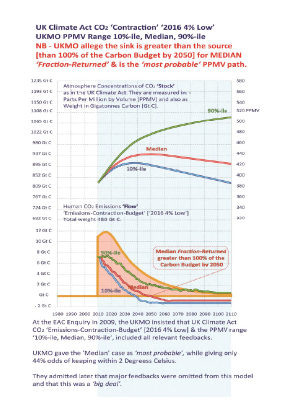
The UK Climate Act
A high-resolution TIFF file of this image is Here
Quick view PDF version of this image Here
6. Feedback Omissions; another form of Climate Denial?
UKMO to EAC Enquiry, June 2013 -
“We are a major player in IPCC AR5.”
During this enquiry, the UKMO’s chief scientist Dr Julia Slingo told the EAC that: -
“We [the UKMO] are a major player in the IPCC and take the process very seriously. In the fifth assessment report [AR5] we have a large number of contributing authors and we have probably contributed more model
simulations than virtually any other group in the world.”
In particular she told the EAC that any charge that UKMO had left significant feedbacks out of its climate-modeling for the UKCA and the IPCC AR5, “was absolutely untrue . . . [adding]. . . to say that we don’t include them is absolutely wrong.”
However, it is the degree of emphasis in this denial that is extraordinary. It is the denial that is obviously false as it completely contradicts the evidence, both as published statements from the UKMO itself and also as results from the UKMO’s climate modeling.
Indeed, it is on the record that making these omissions is exactly what UKMO has knowingly carried out, both in the 20 years leading to the 2008 UKCA and what they have continued to do for the six years since then for the IPCC AR5.
GCI to EAC Enquiry, June 2013
For the EAC Enquiry, GCI analyzed the Climate Act’s many incongruities here.
GCI led this evidence and laid out in great detail a significant range of flaws in the UK Climate Act, now also in AR5, which included the following statement: -
“As the planet warms, a steady rate of feedback acceleration in the years ahead makes it possible to contemplate a scenario where positive feedback is driving the system as a whole from a point after which ‘human-budget-emission-control’ becomes irrelevant. To continue, after twenty years, to ignore this anywhere, let-alone in ‘climate-science-policy modelling’ community is another form of ‘climate-denial’. Doing this unintentionally provides assistance to ‘climate-deniers’ against whom James Hansen has already and rightly levelled the charge of crimes against humanity for willing dangerous rates of climate-change upon the future. For UNFCCC-compliance, the struggle is now between control & a loss of control. To deal with this we need a new approach that will be precautionary, prevention-based and strategically goal-focused. It will distinguish between ‘budget-emissions’ which we can control and ‘feedback emissions’ and effects which we can’t. The approach will quantify as best we can, the runaway potential of rates of change that result from ‘Rapidly Inter Acting Feedback Effects’ [RIAFE] and the dangers of doing too little too late.”
7. Summary of GCI Evidence to EAC the Enquiry
1. The EAC Enquiry is into Global, International and UK Carbon Budgets as defined by the UK Climate Act [UKCA]. The Act consists of the: -
* Global CO2 Emissions ‘Contraction & Concentrations’ scenario [’2016 4% Low’ 2000-2100] which came from the UK Meteorological Office [UKMO] &
* UK share of this using the ‘Contraction & Convergence’ [C&C] methodology which came from the UK Climate Change Committee [CCC].
2. The Act needs revision. As it stands, as it is inadequate, opaque, prescriptive and misleading because of the: -
* UKMO’s omission of major feedback effects from calculation of ‘Contraction & Con-centrations’ scenario & CCC giving only 44% odds for success avoiding more than a 2° temperature rise.
* Emissions ‘Contraction’ should be complete globally by 2050 if, once ‘feedback ef-fects’ are included, we are to give better than 50:50 odds for keeping within the 2° rise.
* CCC also prescribing 2050 as the International ‘Convergence’ year, foregoing the need for any international negotiation of this date.
3. Together, these UKMO-CCC components present an opaque ‘science-policy’ hybrid where the: -
* Climate-model is an opaque ‘black-box’ obscuring the error of feedback-omission and
* Economic-model comes from a suite of opaque ‘black box’ models based on this, which in turn conceals incomplete, contestable and misleading economic computa-tions of ‘price and tax-signals’ and also contains no damage function at all.
4. On the science side of the hybrid, the UKMO: -
* Omitted major feedback effects from ‘2016 4% Low’. Even now this is still not cor-rected and also appears likely to inform IPCC AR5 Working Group One due this year or next;
* Gave retained airborne fraction of anthropogenic emissions greater than 100% by 2050. In the light omitted feedbacks, given ‘3a’, this is an untrustworthy result;
*This was ignored when pointed out by GCI to UKMO in the EAC Enquiry 2009
* UKMO/CCC gave a 56% probability for failing to keep UNFCCC-compliance as tem-perature rose to and then beyond 2° Celsius;
* A UKMO spokesman has implied since then that the figures and values were actually for ‘illustrative purposes only’.
5. On the policy side, the Climate Change Committee: -
* Uncritically accepted the UKMO’s feedback-free Contraction and Concentration projections;
* Super-imposed on that international budgets derived from a prescription for a convergence date of 2050 [C&C 2050] and with this prescribed rate, helped to cause a major international incident at COP-15 in December 2009, over the per-ceived unfairness of this rate of Convergence by 2050 and its prescription.
6.
The misleading effect of this ‘science-policy' hybrid is to project that: -
* We only face only the inconvenience of ‘control-curves’ – or deceleration curves – when feedbacks mean what we face is the potentially catastrophic consequences of ‘loss-of-control-curves’ – or acceleration curves.
* An opaque & feedback-omitting climate-science model is a sufficient basis on which to predict future rates of climate change and UNFCCC-compliance.
* The UK share of this model using convergence as described by the Climate Change Committee [CCC] is a fair and sufficient basis upon which to prescribe the year 2050 for the future convergence for UNFCCC-compliance.
* This in turn is a sufficient basis on which to use opaque and contestable economic models to estimate the ‘price of carbon’ or rates of ‘carbon-tax’ as a function of that procedure.
It would be foolish to continue to deceive ourselves about these matters. To recover, we must be precautionary & not run risks we cannot afford to run. The rates of CO2 emissions & concentrations contemplated in this study, recognize that a steady rate of feedback acceleration in the years ahead makes it possible to contemplate a scenario where positive feedback is driving the system as a whole from a point after which ‘human-budget-emission-control’ is irrelevant.
7. Consequently, there are two simple messages here. We need to:
* Leave fossil carbon [oil coal & gas] in the ground, all in all it is ‘cheaper’;
* Get on with the C&C organised control of ‘human-budget-emissions’ as quickly as possible.
8. So we urge EAC to recommend to the Government the need to: -
* “Understand the need for education to the scale of the challenge for the whole of the planet;” [Turner Walley EAC 2009]
* Be strategically goal-focused on the absolute priority of UNFCCC-compliance [safe and stable GHG concentrations];
* Be seen to be committed to solving the problem faster than we create it;
* See the UK’s transition to a net-zero-carbon future must be accelerated;
* Represent & include all feedback effects and the potential for RIAFE in climate models;
* However difficult, these feedbacks can not credibly be modelled as ‘zero’;
* Separately, measure rates of feedback-emissions as distinct from budget-emissions;
* Integrate these measurements into future science-policy models for UNFCCC-compliance noting, while the former accelerate and are uncontrollable, only the latter are controllable and that the former have a growing potential to overwhelm efforts to control the latter the longer we delay that control;
* Develop, from that safe and stable ppmv value, an inclusive, transparent & precautionary C&C-based policy strategy at rates consistent with UNFCCC-compliance;
* Transparently negotiate and not prescribe an accelerated rate of
international convergence to a year that is ‘agreed-by-the-majority-to-be-fair’ within that C&C scenario.
* Recognize that, in conjunction with the omission of feedback effects, the UKMO have now completely reversed their projections since IPCC AR4 of how carbon sinks will perform in the future.
As stated earlier, the ‘coupled carbon cycle modeling’ previously showed a positive feedback effect in IPCC AR4 [2007] here and here
For the Climate Act and the IPCC AR5, it now shows a strong negative feedback effect.
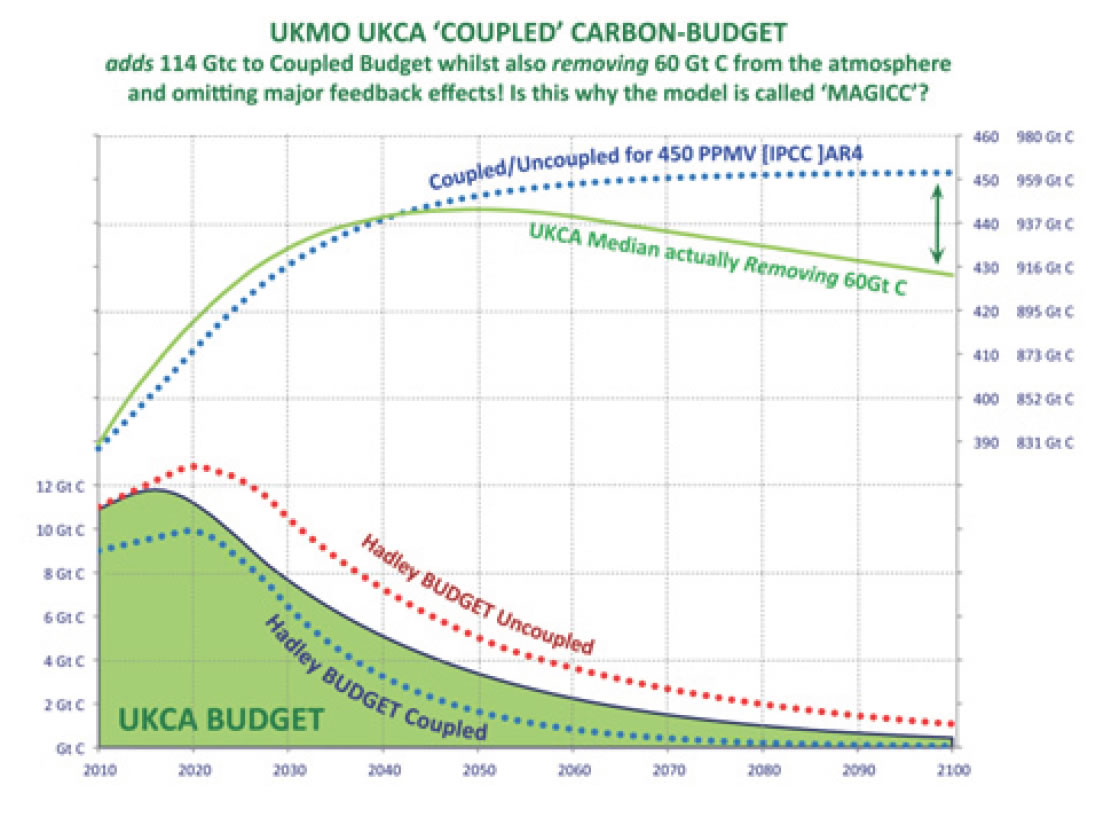
9. The UKMO’s denial is now at the epicenter of the IPCC AR5
The issue of understating the effects and the potential rates of warming over the years ahead, even if emissions controls are applied, is causing some people to begin asking, why and for whose benefit is this conservatively selective modeling being carried out.
Is this is part of the general effort to downplay the seriousness of climate change? If, for example the UK Climate Act ‘as-is’ were expedited, the question begins to haunt this affair as the Act misleads and is inadequate.
Bluntly, why would the UKMO act all of this out this and then defend a position claiming that they hadn’t left anything out of their model, when they so obviously have? The UKMO’s denial is now the epicenter of the IPCC AR5.
10. GCI issued a press release "As is, the UK Climate Act not fit for purpose."
The UK Climate Act (UKCA) has been deemed unfit for purpose as evidence comes to light that the Met Office used flawed modelling, when advising government on the creation of the UK Climate Act and its carbon emissions budget.
The UK Met Office, in conjunction with the UK Climate Change Committee, prescribed a national emissions control regime for the UK [an 80% emissions cut by 2050] as the UK’s ‘equitable share’ of an international agreement mooted to avoid dangerous rates of Climate Change [a 100% emissions cut globally by 2100].
By their own admission, the Act omits major climate-altering feedback effects such as CO2 and CH4 emissions release and atmospheric concentrations rising from melting permafrost. This omission alone is alarming and by definition renders the UKMO’s whole prognosis of ‘climate-control’ inadequate, unreliable and complacent at best.
Aubrey Meyer, Director of the Global Commons Institute, who devised contraction and convergence as a solution to dangerous climate change said:-
“It is alarming that a whole range of these significant and potentially very dangerous feedback effects are still – after 20 years - being entirely omitted from the UKMO’s ‘climate models’. Moreover, UKMO is now feeding this work into the preparations for the IPCC 5th Assessment due in 2014. A growing danger of emissions from Permafrost melt for example is that human efforts to control human‘budget-emissions’ can become overwhelmed by the accelerating release of the non-human ‘feedback emissions’ that will occur uncontrollably as the planet warms. To continue making these omissions now, aids and abets the cause of climate-deniers, people who have already rightly been accused of crimes against humanity by James Hansen.”
Aubrey Meyer recently gave evidence to the Environmental Audit Committee where he outlined the flawed thinking of the UK Met Office.
It is widely recognized that the UK Climate Act of 2008 is based on C&C. But, by prescribing contraction by 2100 with convergence by 2050, it is the rates of C&C asserted in the UKCA that are inadequate & inequitable.
While the C&C Principle is correct, in practice the rates-prescription in UKCA is incapable of generating the international consensus necessary to achieve UNFCCC-
compliance. Global emissions contraction must be fast enough to achieve the objective of the UN Framework Convention on Climate Change [UNFCCC] on a precautionary basis [for example 100% contraction by 2050]. Within this, international convergence on equal shares per person must be negotiated to a rate fast enough to satisfy the Convention’s Equity Principle by rapidly reconciling the growing gap between over-consumers and under-consumers [for example convergence by 2020 or 2030].
Establishing such an agreement, would free humanity from the international deadlock that has frustrated negotiations for the last 20 years. It would create a new momentum of creativity and common purpose and give future generations better prospects than those they face without it.
11. Source:Sink record; climate-policy-models & UNFCCC-compliance
IPCC’s role has been to collate the results of climate-modeling from the climate science community to and for the climate policy community around the United Nations Framework Convention on Climate Change [UNFCCC]. The objective of the UNFCCC is achieving future concentrations that are stable and safe.
While the IPCC does not perform the role of producing ‘policy-models’, the climate-
models are for ‘policy-purposes’ in that they inform policy-makers who grapple with the issue of how the community as a whole becomes UNFCCC-compliant.
Atmospheric GHG concentrations are primarily accumulations of GHG emissions. So future carbon emissions need to contract overall, if future atmospheric carbon concentrations are to slow and stop rising. In principle it is a simple stock:flow relationship.
As with a bath, where tap water flows in and accumulates while water flows out through the plug-hole, if the tap and the plug are flowing at the same rate, the bath-level does not change.
From 1800, when emissions from these human sources started to become significant, on average the atmosphere retained on a cumulative basis a fraction of 50%. The other 50% returned about half and half to the sinks on land and in the ocean. In the analogy the bath level rose at half the rate the tap flowed in, as the land-ocean plug drained away half of what flowed in from the tap.
Since the publishing of the Berne Climate Model runs in IPCC in 1994, climate models have centered on the primary future relationship between human source GHG emissions [80% from fossil fuel burning and 20% from land-use changes] and the consequential concentration in the global atmosphere of just that.
The Berne model reflected that, in a way that no-one has yet decisively explained and measured, these ‘natural sinks’ were apparently ‘enlarging’ to accommodate this extra, mostly ‘fossil-carbon’, into the ‘biological carbon’ cycle. What had already happened, could reasonably be measured even if not completely explained. This was so far so good. But policy questions center on what will happen in future?
The problems become rather different when we project source:sink assumptions forward in models trying to answer this question? The 2008 UK Climate Act for example faces this with a human emissions budget from a climate model that omits a whole range of these feedback effects.
Consequently, what is projected as increased sink-capacity relative to sources is unrealistic. Consequently, what is projected as the likely minimum temperature of an overall two degree rise is an under-estimate. The effect of these omissions now informs the final output of IPCC AR5 and thus seriously understates the rate and the degree of the climate changes that are likely to be seen once the effects are added in.
12. James Hansen ex-NASA tells EAC, UKCA “too weak.”
EAC Chair
"We are undertaking an inquiry looking at the UK’s carbon budget regime, intermediate targets on the path to the UK’s statutory target to cut emissions by 80% by 2050. That UK carbon budget regime is based on the objective of limiting global temperature rises to 2°C. Is that still the right objective?"
Professor Hansen:
"Well, 2°C is the limit. The community has agreed that 2°C is an upper boundary that we should avoid penetrating. I argue that the limit should be lower than that. We know that the last time the world was 2°C warmer was 120,000 years ago in the Eemian Period, and things were rather different then. The sea level was at least six metres higher. From the earth’s history we know that, as the temperature has changed, the sea level has gone along with it, because ice melts when the planet gets warmer, and so the eventual response to 2°C warming is probably going to be a situation that is rather unacceptable. There is no evidence that would indicate that that target is too ambitious. If anything, it is too weak."
In a recent Envision movie: -
James Hansen said: -
“The Arctic is warming faster than most places on the planet. And that’s partly because of the sea ice because it would begin to lose some of its sea ice if it exposes the darker the ocean because it absorbs more sunlight that causes the ocean to warm further and melt more ice. There are potential irreversible effects of melting the sea ice if it begins to allow the Arctic Ocean to warm up and warm the ocean floor, then we’ll begin to release methane hydrates and if we let that happen that’s a potential tipping point that we don’t want to pass.”
13. Prof Peter Wadhams of Cambridge University on IPCC AR5 omissions
Prof Peter Wadhams, co-presenter with Hansen in that movie, recently commented in the FT
One was a contentious decision to exclude a best estimate for future sea level rises because it was thought the potential impact of ice sheets was still too poorly understood. Wadhams, along with other critics, believes this led to a serious underestimate of how high sea levels will rise.
“They just chickened out,” he fumes. “I mean, in a really systematically cowardly way. And it shows how naive these scientists are or how terrified of sticking their neck out.”
Wadhams is even angrier about another line in that last IPCC report suggesting it could take until the latter part of this century before Arctic summer sea ice disappears almost entirely. The sea ice that covers much of the North Pole always melts a little in summer and then refreezes as winter sets in. Last summer, however,
it shrank to its lowest point in more than 30 years, a much more dramatic decline than predicted. Wadhams thinks it more likely that its summer sea ice will vanish as soon as 2015.
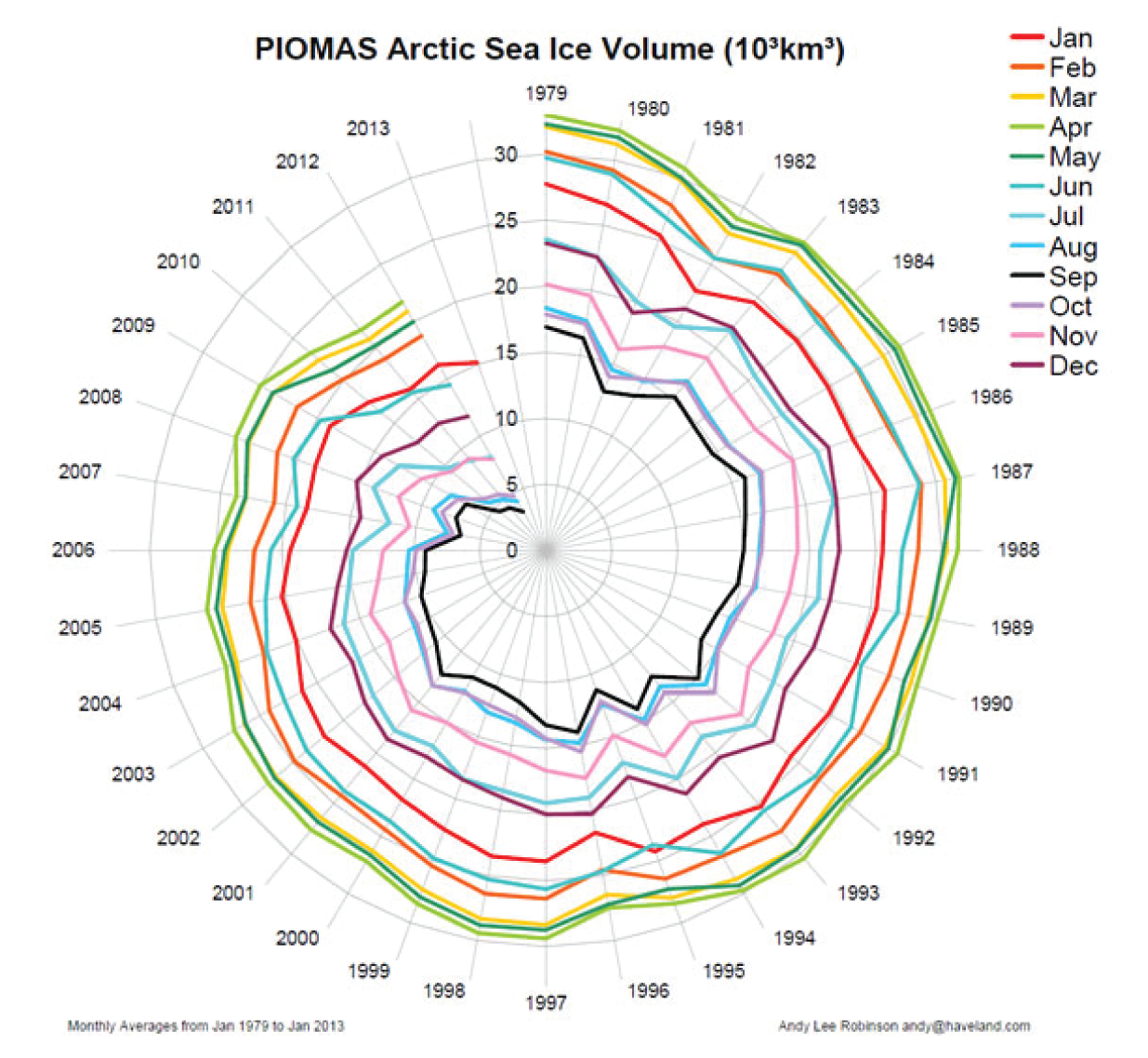
“It could even be this year or next year but not later than 2015 there won’t be any ice in the Arctic in the summer,” he said, using a diagram explaining his calculations, which he calls “the Arctic death spiral”.”
14. Dr. T. Shindell of NASA ‘at present probability can’t be judged reliably.’
“The rarity of paleo-climate evidence for hydrate-induced climate changes argues this is a fairly unlikely candidate for near-term sudden climate change. Unlike the others, however, anthropogenic climate change may alter the probability of hydrate release when compared with the past, making the overall probability of near-term release extremely difficult to estimate. Massive methane release by hydrates or from peats also seems to have been extremely rare in the past, but could become more probable in the future world under the influence of anthropogenic forcing. However, at present, it is not possible to judge the probability for such changes reliably.”
15. Prof Peter Wadhams defends his analysis
The 24 07 story about the potential cost of Arctic methane release has provoked widespread coverage, including a critique in the Washington Post. Here, Professor Peter Wadhams responds to some of the comments that were made.
The 25 July post by Jason Samenow on the global economic impacts of methane emissions in the East Siberian Sea portrays the findings of our research as misleading, a statement with which I strongly disagree. Our work is based on a prediction of the magnitude and timing of ethane emissions from the thawing of Arctic offshore permafrost by a scientist who has done extensive field work on this part of the ocean bed and is a globally recognized expert. We calculated the financial implications of these emissions for the world economy over a century and also considered the effect of the emissions on increasing overall global warming, obtaining a 0.6C figure by 2040. We rightly consider these to be substantial figures, which deserve wide circulation among climate scientists, and Nature and its referees agreed with us.
In our analysis we showed that the overall cost of a given volume of methane release is relatively insensitive to the rate of release or, within limits, its timing, BUT that the cost is roughly proportional to the overall volume of release. Thus, even if you worked with a different projection by a lesser qualified scientist than Shakhova, and revised down the figure and scale of the 60 trillion dollars accordingly, I suspect the cost will still be substantial– and that is one clear finding: The planetary cost of Arctic warming far outstrips any possible benefits to shipping or natural resource exploration.
In support of its scepticism about methane emissions the article quoted authors who wrote before the enormous retreat of summer Arctic sea ice and its oceanographic effects became so evident. The mechanism which is causing the observed mass of rising methane plumes in the East Siberian Sea is itself unprecedented and the scientists who dismissed the idea of extensive methane release in earlier research were simply not aware of the new mechanism that is causing it.
What is happening is that the summer sea ice now retreats so far, and for so long each summer, that there is a substantial ice-free season over the Siberian shelf, sufficient for solar irradiance to warm the surface water by a significant amount – up to 7C according to satellite data. That warming extends the 50 m or so to the seabed because we are dealing with only a polar surface water layer here (over the shelves the Arctic Ocean structure is one-layer rather than three layers) and the surface warming is mixed down by wave-induced mixing because the extensive open water permits large fetches. So long as some ice persisted on the shelf, the water mass was held to about 0C in summer because any further heat content in the water column was used for melting the ice underside. But once the ice disappears, as it has done, the temperature of the water can rise significantly, and the heat content reaching the seabed can melt the frozen sediments at a rate that was never before possible.
The 2008 US Climate Change Science Program report needs to be seen in this context. Equally, David Archer’s 2010 comment that “so far no one has seen or proposed a mechanism to make that (a catastrophic methane release) happen” was not informed by the Semiletov/Shakhova field experiments and the mechanism described above. Carolyn Rupple’s review of 2011 equally does not reflect awareness of this new mechanism.
Therefore I robustly defend our research and commentary, and hope that rather than dis-miss the substantial risk such a methane release poses, the response might be to support more intensive research on this problem. See more here
16. UNEP 2012 “Policy Implications of Warming Permafrost.” [Feedbacks]
In 2012, UNEP published “The Policy Implications of Warming Permafrost.”
In the executive summary it made the following statements about IPCC AR5 and the omission of carbon feedback in the climate models that under-pin AR5.
-
"All climate projections in the IPCC Fifth Assessment Report, due for release in 2013-14, are likely to be biased on the low side relative to global temperature because the models did not include the permafrost carbon feedback.
-
Consequently, targets for anthropogenic greenhouse gas emissions based on these climate projections would be biased high.
-
The treaty in negotiation sets a global target warming of 2°C above pre-industrial temperatures by 2100.
-
If anthropogenic greenhouse gas emissions targets do not account for CO2 and methane emissions from thawing permafrost, the world may overshoot this target.”
17. Nicholas Stern published slides at the IMF [05 2013] [Feedbacks]
On slide 9 and 10 Stern also points to the omission of melting Permafrost feedbacks and tipping points: -
-
”The scientific models mostly leave out dangerous feedbacks/tipping points.
-
At 6°, 5°, 4° C or below, the probability of passing some tipping points, such as melting of permafrost, may be high. If modellers cannot capture or model effects ‘sufficiently clearly’ they are omitted. But best guess surely not zero.
-
The models are not built in a way that help us describe the impacts on people:
-
At sea level (SL) 2m higher a few hundred million might have to move (Nicholls, et al., 2011);
-
At 3-4-5°C may see radical monsoon changes in India and substantial changes in flows of major rivers off the Himalayas (a billion plus people depend on them). Desertification of southern Europe?
-
Models should focus on understanding probabilities of events with severe consequences for people rather than on those bits which (on narrow assumptions) seem more tractable, such as change in agricultural output, relative to those effects that can be modelled more easily.
-
We need new generation of models.”
18. Various UKMO statements admitting omission of Feedbacks
Are there feedbacks that aren’t included in the models?
UKMO - “There are some feedbacks we have recognised but remain big uncertainties. We don’t know enough about them to include their effects in climate models. However, they are potentially very serious so there is still a lot of work going on to try to understand them and get them into our projections.”
Methane hydrates (positive feedback)
UKMO - “These are potentially a very big deal which could change our whole understanding of climate change, but it’s very uncertain. There are very large stores of methane locked away at depth in the ocean. We know the stability
of these stores is dependent on temperature. As the oceans get warmer it’s possible this balance could be upset and the stores released — which would be very serious. Methane is more than 20 times as potent as CO2 as a greenhouse gas. There’s some evidence to suggest that going back over a very long historical period (more than millions of years), the release of these methane stores may have played a big role in abrupt and severe changes to past climate. How close we are to any possible threshold is very much an open question.”
Permafrost methane (positive feedback)
UKMO - “This is a big question mark but also potentially a very big deal. There are very organic rich soils in certain parts of the world. At higher latitudes,
these are frozen over by permafrost, and those greenhouse gases are effectively locked away. When the soil thaws due to rising temperatures, these gases could become unlocked and be released as CO2 or methane. At the moment we don’t know how much of the CO2 is stored away or to what extent it would be released when the soil thaws. These are two key questions,
and we need to figure out how to resolve them on a global scale in a climate model before this effect can be included in our projections. Within the next five years we hope to know enough about this process to start including its effects.”
Could there be other feedbacks that you don’t yet know about?
UKMO - “Yes, we assume there are hidden feedbacks in the system, but as long as we keep climate change relatively small we can be confident these unknown issues won’t come in to play. However, as we move further away from the present climate, we are exposing ourselves to more risk about these unknowns. Even only taking into account the climate feedbacks we are aware of now, they pose a great incentive for us to quickly reduce our greenhouse gas emissions to keep global temperature rises to a minimum.”
What follows simply re-stated what the UKMO was obliged to confirm in 2010 after the EAC enquiry in 2009 [last updated 29 April 2013]: -
UKMO: -
“We will continue to improve the representation of processes included in our model. There are also a number of processes not currently included that could potentially have a major impact on the degree of warming for a given emissions scenario, quite apart from their impact on local and regional climate. Some of these processes have been discussed here and we are actively working on including them in the model: -
-
The impact of ozone on plants reduces their ability to take up carbon. Given their major implications for international technology and economic development, policy decisions on climate change must be underpinned by the best possible evidence.
-
The deposition of black carbon on snow changes the reflectivity of the surface leading to more warming at high latitudes. Other processes are less well understood but are actively being researched with a view to including them in future models.
-
The ability of plants to take up carbon may be limited by the supply of nitrogen available naturally, but may be enhanced by man-made sources of nitrogen. Climate change itself may also increase available nitrogen and stimulate plant growth.
-
The thawing of permafrost may lead to large amounts of carbon release, but these processes are not well understood.
-
Dynamic ice processes could speed up freshwater supply from glaciers into the ocean.
-
The processes that affect methane in the Arctic Ocean could lead to increased methane release (the science is poorly understood so may take longer to include in models).
The international science community is working hard to understand and narrow the uncertainties in future climate projections — and it is doing this primarily through model inter-comparison projects, comparison with observations, and the synthesis of results by the next IPCC report. Understanding the interactions within the Earth system is critical.”
As the UKMO stated very recently [July 2013] again: -
“Other Earth system feedbacks, associated for example with the cycling of carbon
through natural systems and releases of carbon from permafrost melt, will change, and are likely to increase the actual expected warming.”
19. Carbon Budget Accounting Tool [CBAT] & Handling Omitted Feedbacks
GCI has proposed the Carbon Budget Accounting Tool [CBAT] to the EAC to start a conceptual process where the effects of these feedback effects can be represented and trend-integrated into Climate & Policy models
[INFO - ‘HELP’ button].
Compare Integrated Feedback Effects [UKMO & omissions] with
Segregated Feedback Effects [CBAT & inclusions]
20. UKMO’s ‘Control Curves’ vs CBAT’s potential Loss of Control Curves
UKMO’s Control Curves versus CBAT’s potential Loss of Control Curves
Here we compare the Upper Band deceleration ‘feedback-curve’ generated by the UKMO model with the acceleration ‘feedback-curve’ generated by CBAT. These coincide at 516 PPMV in 2110. UKMO’s deceleration curves goes above the PPMV trend at the outset. Then, because many feedback effects were omitted from their model, the PPMV curve decelerates to stasis, even though UKMO assert that the planet will warm another degree Celsius during the 21st Century. This is obviously unrealistic as inter alia much Arctic and Permafrost melt will occur during this period, as the slow start CBAT acceleration curves show.
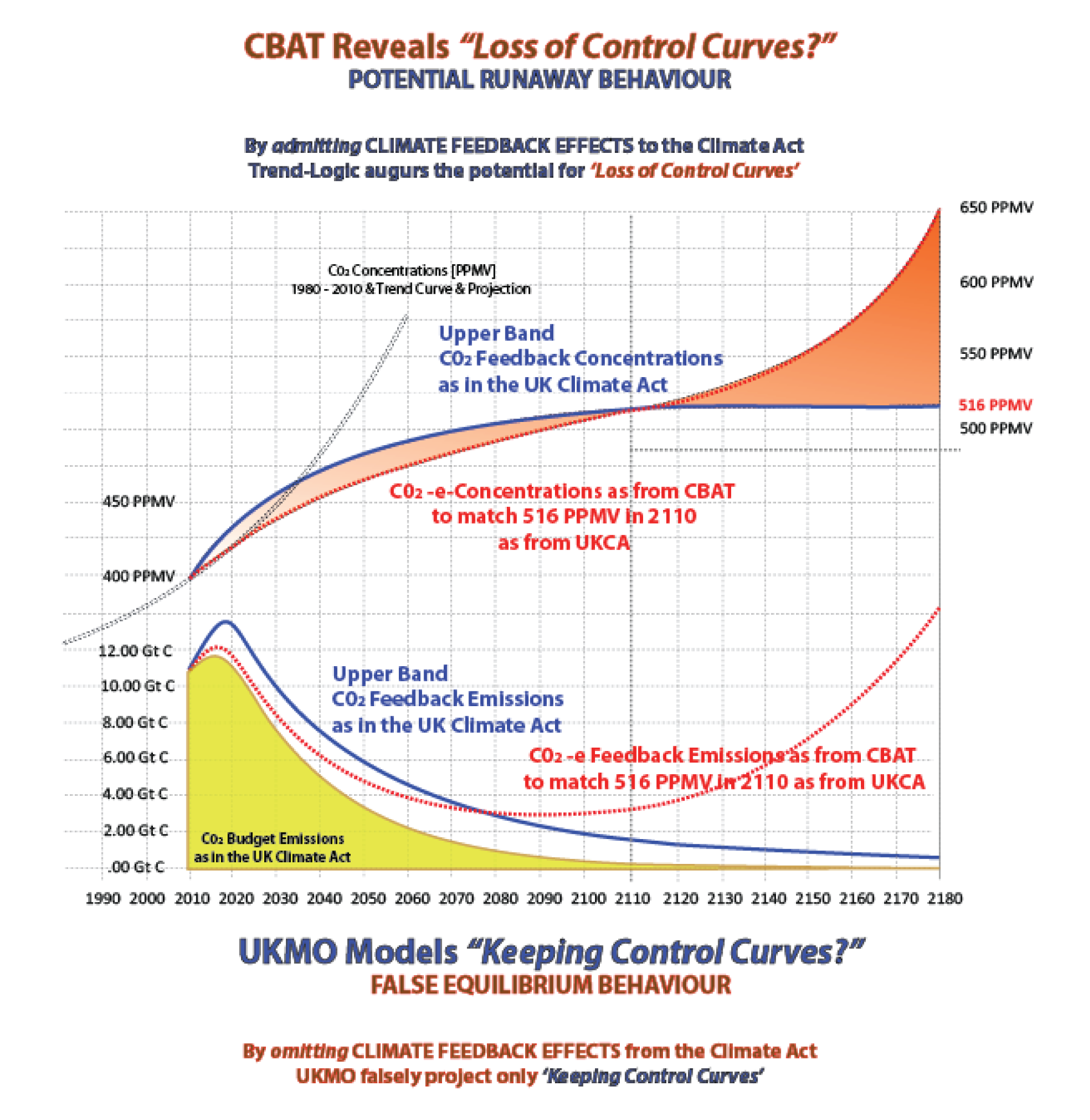
21. CBAT Low Budget Domains 1 & 2 CBAT Medium [UKCA] “too weak.”
22. Graphics [quoted] showing UKMO/RCP reconciliation exercise.
23. IPCC AR5 RCP 2.6 virtually is UKCA & “56% odds of exceeding 2° C.”
24. FINAL DRAFT IPCC ARG WG1 TS on Climate Feedbacks [quoted]
25. Some Responses to CBAT